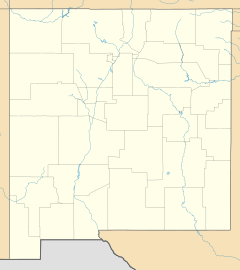El Santuario de Chimayo
|
El Santuario de Chimayó
|
|
 |
|
| Location | 1 mi. NW of Santa Cruz Reservoir Dam |
|---|---|
| Nearest city | Chimayó, New Mexico |
| Coordinates | 35°59′21.00″N 105°55′54.00″W / 35.9891667°N 105.9316667°WCoordinates: 35°59′21.00″N 105°55′54.00″W / 35.9891667°N 105.9316667°W |
| Built | 1816 |
| Architect | Unknown |
| Architectural style | No style listed |
| NRHP Reference # | 70000412 |
| Significant dates | |
| Added to NRHP | April 15, 1970 |
| Designated NHL | April 15, 1970 |
El Santuario de Chimayó is a Roman Catholic church in Chimayó, New Mexico, United States. (Santuario is Spanish for "sanctuary".) This shrine, a National Historic Landmark, is famous for the story of its founding and as a contemporary pilgrimage site. It receives almost 300,000 visitors per year and has been called "no doubt the most important Catholic pilgrimage center in the United States."
The Santuario is on Juan Medina Drive in Chimayó. It is entered through a walled courtyard. Built of adobe with a bell tower on each side, the church is 60 feet (18 m) long and 24 feet (7.3 m) wide with walls more than 3 feet (about 1 m) thick. Pointed caps on the towers and a metal pitched roof (blocking the clerestory) were added after 1917, probably in the 1920s. The "elegant" doors were carved by the 19th-century carpenter Pedro Domínguez. An unusual feature is two side-by-side rooms at the entrance forming a vestibule or narthex, once used for storage. The nave contains a crucifix by the santero "Molleno" (fl. 1800–1850) representing Christ of Esquipulas, 6 feet (1.8 m) tall. Other notable folk-art decorations include five reredoses and a small sculpture of St. James the Great. A small room called el pocito (the little well) contains a round pit, the source of "holy dirt" (tierra bendita) that is believed to have healing powers. An adjacent Prayer Room displays many ex-votos as well as photographs, discarded crutches, and other testimonials of those purportedly healed.
In the early 19th Century, nineteen families lived in what was then called El Potrero de Chimayó (potrero means pasture). The land where the Santuario now stands belonged to Don Bernardo Abeyta, one of the first members of Los Hermanos de la Fraternidad Piadosa de Nuestro Padre Jesús Nazareno (the Penitentes) in the area. Also, he was probably devoted to the Christ of Esquipulas, a pilgrimage site in Guatemala where the clay is ascribed healing power. A nephew of Don Bernardo was christened Juan de Esquipulas in 1805.
...
Wikipedia


